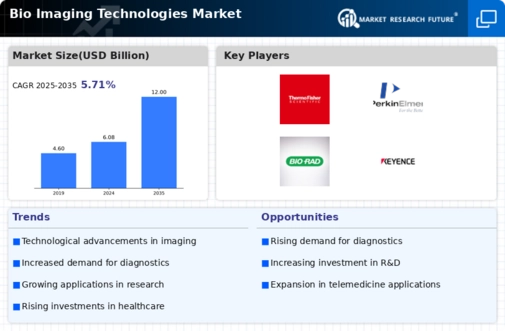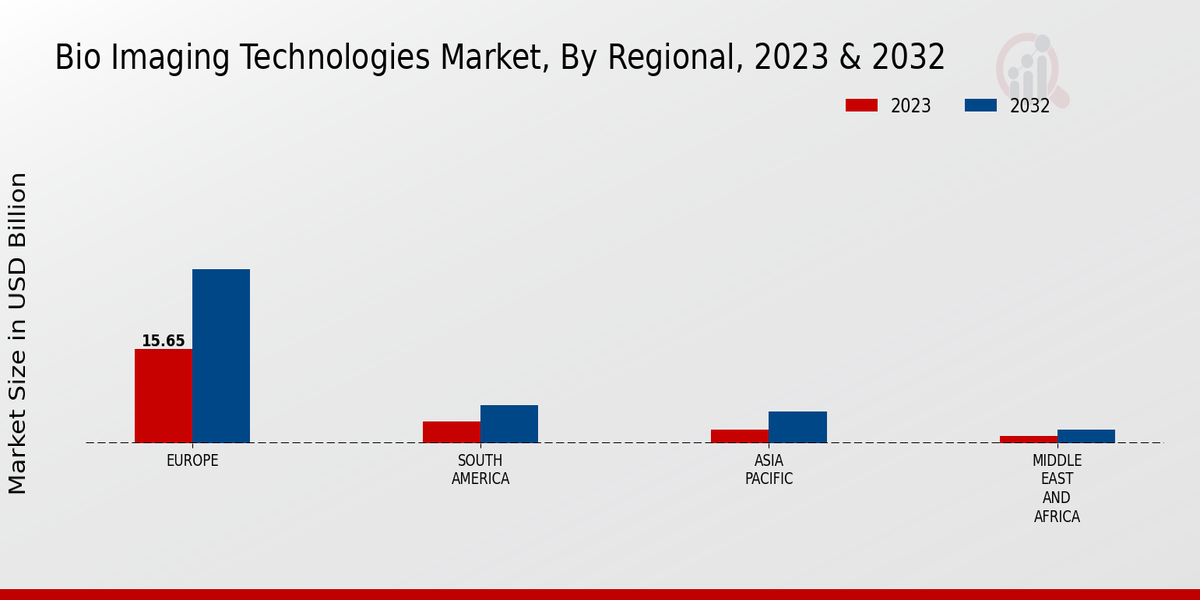Growing Geriatric Population
The Global Bio Imaging Technologies Market Industry is propelled by the growing geriatric population, which is more susceptible to various health conditions requiring advanced imaging solutions. As individuals age, the likelihood of developing chronic diseases increases, necessitating regular imaging for early detection and management. The World Health Organization projects that the global population aged 60 years and older will reach 2.1 billion by 2050. This demographic shift creates a heightened demand for imaging technologies, as healthcare systems adapt to the needs of older adults. Consequently, the market is expected to grow significantly, reflecting the anticipated CAGR of 6.41% from 2025 to 2035.
Market Trends and Projections
The Global Bio Imaging Technologies Market Industry is characterized by various trends and projections that highlight its growth potential. The market is expected to expand from 6.08 USD Billion in 2024 to 12.0 USD Billion by 2035, reflecting a CAGR of 6.41% from 2025 to 2035. Key trends include the increasing adoption of hybrid imaging technologies, such as PET/MRI, which combine the strengths of multiple modalities for enhanced diagnostic capabilities. Additionally, the rise of point-of-care imaging solutions is transforming the landscape, making advanced imaging more accessible. These trends indicate a dynamic market environment, poised for innovation and growth.
Rising Healthcare Expenditure
The Global Bio Imaging Technologies Market Industry benefits from the rising healthcare expenditure across various regions. Increased investment in healthcare infrastructure and technology enhances access to advanced imaging solutions. Governments and private sectors are allocating more resources to improve diagnostic capabilities, which is evident in the expansion of imaging facilities and the adoption of cutting-edge technologies. As healthcare budgets grow, the demand for sophisticated imaging modalities, such as MRI and CT scans, is likely to rise. This trend supports the market's growth trajectory, with expectations of reaching 12.0 USD Billion by 2035, following a valuation of 6.08 USD Billion in 2024.
Increasing Prevalence of Chronic Diseases
The Global Bio Imaging Technologies Market Industry is significantly influenced by the rising prevalence of chronic diseases such as cancer, cardiovascular disorders, and neurological conditions. These diseases necessitate advanced imaging solutions for accurate diagnosis and treatment monitoring. For example, the demand for PET and CT scans has surged as they provide critical insights into disease progression. The increasing burden of these health issues drives investment in imaging technologies, contributing to the market's expansion. As healthcare providers seek to enhance diagnostic capabilities, the market is poised for continued growth, aligning with the projected increase from 6.08 USD Billion in 2024 to 12.0 USD Billion by 2035.
Regulatory Support and Funding Initiatives
The Global Bio Imaging Technologies Market Industry is positively impacted by regulatory support and funding initiatives aimed at advancing medical imaging technologies. Governments and health organizations are increasingly recognizing the importance of imaging in healthcare, leading to the establishment of grants and funding programs to support research and development. For instance, initiatives that promote innovation in imaging technologies facilitate the introduction of novel solutions into the market. This supportive environment encourages collaboration between public and private sectors, fostering advancements that enhance diagnostic accuracy and patient care. As a result, the market is likely to witness sustained growth, aligning with the projected CAGR of 6.41% from 2025 to 2035.
Technological Advancements in Imaging Techniques
The Global Bio Imaging Technologies Market Industry experiences substantial growth due to rapid advancements in imaging technologies. Innovations such as high-resolution MRI, PET scans, and advanced ultrasound systems enhance diagnostic capabilities. For instance, the integration of artificial intelligence in imaging analysis improves accuracy and efficiency, leading to better patient outcomes. As of 2024, the market is valued at approximately 6.08 USD Billion, with projections indicating a rise to 12.0 USD Billion by 2035. This growth reflects a compound annual growth rate (CAGR) of 6.41% from 2025 to 2035, underscoring the importance of technological evolution in the sector.















